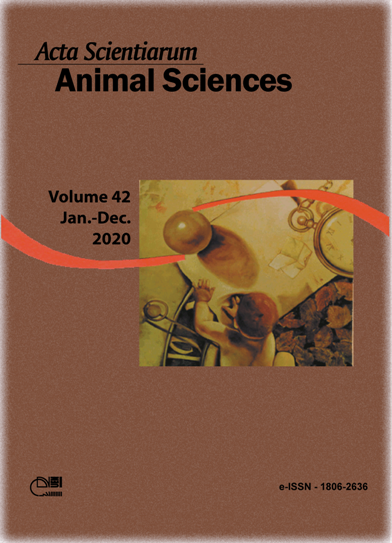Chemical control of signalgrass for establishing Tanzania-grass
Resumo
Herbicides have been used to control Brachiaria grass in pastures established or in formation given their practicality, however their efficiency is questionable due to the lack of specific graminicides for different forage species. Therefore, the goal of this study was to evaluate the efficiency of glyphosate and fluazifop-p-butyl in the control of Brachiaria decumbens (signalgrass) and the intoxication levels of Panicum maximum cv. Tanzania (Tanzania quinea grass) in pasture establishment. The experiments were designed in randomized blocks, in a 2 × 5 × 4 factorial arrangement of two herbicides (fluazifop-p-butyl and glyphosate), five doses equivalent to the commercial dosage of each herbicide (0.25; 0.50; 1.00; 1.50; 200), and four evaluation times after herbicide application (15, 21, 30 and 45 days). There was interaction between doses and evaluation times. The dose 1.5 L ha-1 fluazifop-p-butyl provides efficient control of signalgrass, however, leads to high intoxication in Tanzania guinea grass. Glyphosate is efficient in the control of signalgrass even at the lowest dose (90 g ha-1), however, it causes high intoxication in Tanzania guinea grass, preventing its use in developing pastures. It can be concluded that fluazifop-p-butyl and glyphosate herbicides are not recommended for the control of B. decumbens, cv. Basilisk in developing pastures of Tanzania guinea grass.
Downloads
Referências
Alarcón-Reverte, R., García, A., Watson, S. B., Abdallah, I., Sabaté, S., Hernández, M. J., Dayan, F. E., & Fischer, A. J. (2015). Concerted action of target-site mutations and high EPSPS activity in glyphosate-resistant junglerice (Echinochloa colona) from California. Pest Management Science, 71(7), 996-1007. doi: 10.1002/ps.3878
Anésio, A. H. C., Santos, M. V., Silveira, R. R., Ferreira, E. A., Braz, T. G.S., Tuffi Santos, L. D., & Santos, J. B. (2017). Herbicide selectivity to Signal Grass and Congo Grass. Planta Daninha, 35. doi: 10.1590/s0100-83582017350100062
Barroso, A. L. L., Dan, H. A., Procópio, S. O., Toledo, R. E. B., Sandaniel, C. R., Braz, G. B. P., & Cruvinel, K. L. (2010). Eficácia de herbicidas inibidores da ACCase no controle de gramíneas em lavouras de soja. Planta Daninha, 28 (1). 149-157. doi: 10.1590/S0100-83582010000100018
Burke, I. C., Thomas, W. E., Burton, J. D., Spears, J. F., & Wilcut, J. W. (2006). A seedling assay to screen aryloxyphenoxypropionic acid and cyclohexanedione resistance in johnsongrass (Sorghum halepense). Weed Technology, 20(4): 950-955. doi: 10.1614/WT-05-160.1
Cecato, U., Machado, A. O., Martins, E. N., Pereira, L. A. F., Barbosa, M. A. A. F., & Santos, G. T. (2000). Avaliação da produção e de algumas características da rebrota de cultivares e acessos de Panicum maximum Jacq. sob duas alturas de corte. Revista Brasileira de Zootecnia, 29(3). doi: 10.1590/S1516-35982000000300004
Dias, R. C., Santos, M. V., Oliveira, F. L. R., Ferreira, E. A., Santos, J. B., Rodrigues, B. M., & Martins, C. A. (2017). Chemical control of signalgrass in alfafa crops. Semina: Ciências Agrárias, 38 (6), 3695-3704. doi:10.5433/1679-0359.2017v38n6p3695
European Weed Research Council [EWRC]. (1964). Report of the 3rd and 4th meetings of EWRC - Comittee of Methods in Weed Research. Weed Research, 4(1), 88.
Gronwald, J. W. (1991). Lipid biosynthesis inhibitors. Weed Science, 39 (3), 435-449.
Jank, L., Braz, T. G. S., & Martuscello, J. A. (2013). Gramíneas De Clima Tropical. In: R. A. Reis, T. F. Bernardes, & G. R. Siqueira (Orgs), Forragicultura: Ciência, tecnologia e gestão dos recursos forrageiros. Jaboticabal: Editora: Funep, 8, 109-119.
Jank, L., Marstuscello, J. A., Euclides, V. P. B., Valle, C. B., & Resende, R. M. S. (2010). Panicum maximum. In: Fonseca, D. M., & Martuscello, J A. (Orgs), Plantas Forrageiras. Viçosa, MG: UFV.
Kaundun, S. S. (2014) Resistance to acetyl-CoA carboxylase inhibiting herbicides. Pest Manage Science, 70 (9), 1405-1417. doi: 10.1002/ps.3790
Ohlrogge, J. B., & Browse, J. (1995). Lipid biosynthesis. The Plant Cell, 7, 957-970.
Pereira, J. R., & Campos, A. T. (2001). Controle da braquiária como invasora - Instrução técnica para o produtor de leite. Juiz de Fora, MG: Embrapa Gado de Leite.
Santos, M. V., Ferreira, F. A., Freitas, F. C. L., Fonseca, D. M., Carvalho, A. C., & Braz, T. G. S. (2012). Brachiaria brizantha control by using fluazifop-p-butil on Tifton 85 pasture formation. Revista Brasileira de Zootecnia, 41(2), 281-285. doi: 10.1590/S1516-35982012000200007
Santos, M. V., Freitas, F. C. L., Ferreira, F. A., Carvalho, A. J., Braz, T. G. S., Cavali, J., & Rodrigues, O. L. (2010). Tolerância do Tifton 85 ao glyphosate em diferentes épocas de aplicação. Planta Daninha, 28 (1), 31-137. doi: 10.1590/S0100-83582010000100016
Silva, J. De L., Ribeiro, K. G., Herculano, B. N., Pereira, O. G., Pereira, R. C., & Soares, L. F. P. (2016). Massa de forragem e características estruturais e bromatológicas de cultivares de Brachiaria e Panicum. Ciência Animal Brasileira, 17, 342-348. doi: 10.1590/1089-6891v17i332914
Vidal, M. (1997). The reverse Two-Hybrid System. In P. L. Bartel, & S. Fields (Eds.), The Yeast Two-Hybrid System. New York, NY: Oxford University Press: New York.
DECLARAÇÃO DE ORIGINALIDADE E DIREITOS AUTORAIS
Declaro que o presente artigo é original, não tendo sido submetido à publicação em qualquer outro periódico nacional ou internacional, quer seja em parte ou em sua totalidade.
Os direitos autorais pertencem exclusivamente aos autores. Os direitos de licenciamento utilizados pelo periódico é a licença Creative Commons Attribution 4.0 (CC BY 4.0): são permitidos o compartilhamento (cópia e distribuição do material em qualqer meio ou formato) e adaptação (remix, transformação e criação de material a partir do conteúdo assim licenciado para quaisquer fins, inclusive comerciais.
Recomenda-se a leitura desse link para maiores informações sobre o tema: fornecimento de créditos e referências de forma correta, entre outros detalhes cruciais para uso adequado do material licenciado.








































